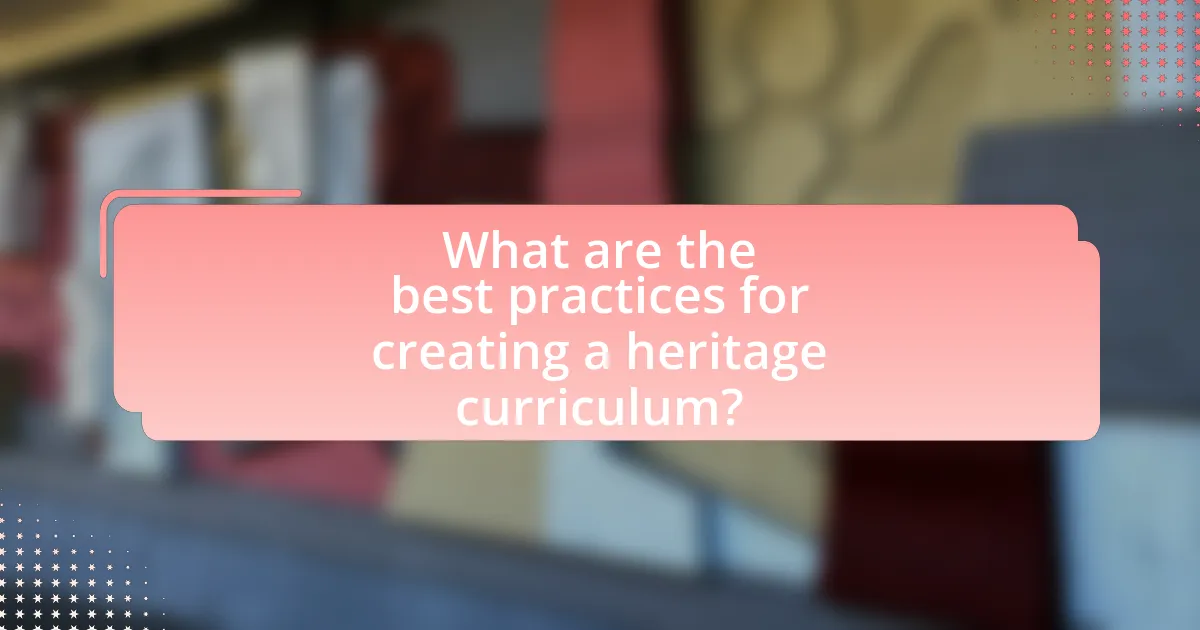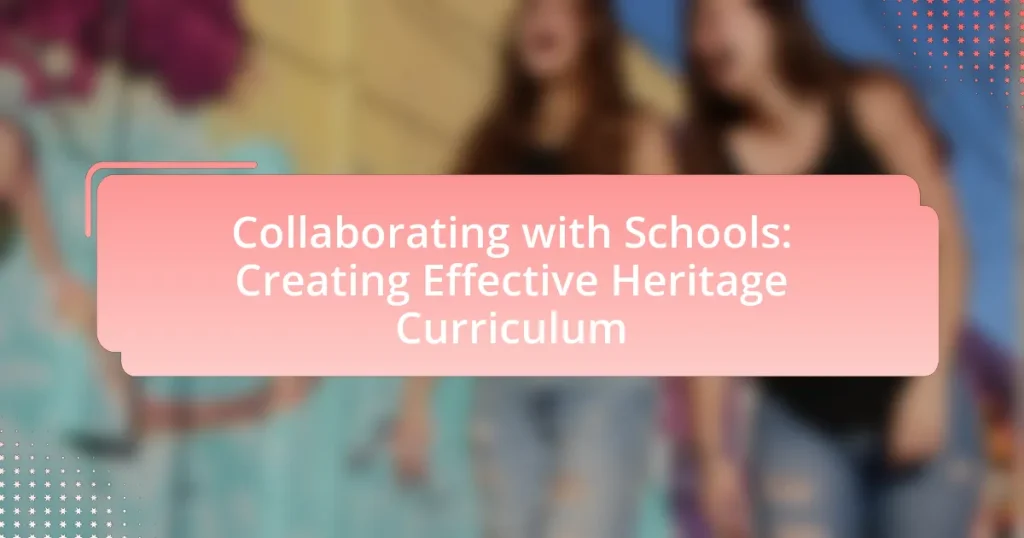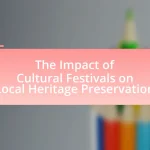Collaborating with schools to create an effective heritage curriculum involves partnerships among educational institutions, community organizations, and cultural stakeholders to develop a curriculum that reflects local heritage. This collaboration enhances student engagement and learning outcomes by integrating diverse perspectives and expertise, ensuring the curriculum is culturally relevant and inclusive. Key elements for successful collaboration include clear communication, shared goals, and mutual respect, while challenges such as misaligned objectives and resource constraints must be addressed. The article outlines strategies for identifying suitable partners, implementing the curriculum, and evaluating its effectiveness, emphasizing the importance of community involvement and continuous feedback for improvement.

What is Collaborating with Schools to Create an Effective Heritage Curriculum?
Collaborating with schools to create an effective heritage curriculum involves partnerships between educational institutions, community organizations, and cultural stakeholders to develop a curriculum that reflects and honors local heritage. This collaboration ensures that the curriculum is relevant, inclusive, and representative of the diverse histories and cultures within the community. Research indicates that such partnerships enhance student engagement and learning outcomes by providing authentic learning experiences that connect students to their cultural roots and community history. For example, studies show that when schools work with local historians and cultural organizations, students demonstrate improved academic performance and a deeper understanding of their heritage.
How does collaboration enhance the development of a heritage curriculum?
Collaboration enhances the development of a heritage curriculum by integrating diverse perspectives and expertise from various stakeholders, including educators, community members, and cultural organizations. This collective input ensures that the curriculum is culturally relevant, accurate, and reflective of the community’s heritage. For instance, research conducted by the National Council for the Social Studies highlights that collaborative curriculum development leads to more inclusive educational practices, which can improve student engagement and understanding of their cultural backgrounds. By working together, stakeholders can share resources, knowledge, and best practices, ultimately creating a more comprehensive and effective heritage curriculum.
What are the key elements of effective collaboration between schools and heritage organizations?
Effective collaboration between schools and heritage organizations hinges on clear communication, shared goals, and mutual respect. Clear communication ensures that both parties understand each other’s needs and expectations, facilitating a productive partnership. Shared goals align the educational objectives of schools with the cultural and historical missions of heritage organizations, fostering a cohesive approach to curriculum development. Mutual respect acknowledges the expertise and contributions of both educators and heritage professionals, creating an environment conducive to innovative programming. Research indicates that partnerships that incorporate these elements lead to enhanced student engagement and deeper learning experiences, as evidenced by successful initiatives documented in studies such as “The Role of Cultural Heritage in Education” by the National Endowment for the Humanities.
How can schools identify suitable partners for collaboration?
Schools can identify suitable partners for collaboration by assessing shared goals, resources, and expertise relevant to their educational objectives. This involves conducting a needs assessment to determine specific areas where collaboration could enhance the curriculum, such as heritage education. Schools can then research potential partners, including local cultural organizations, universities, and community groups, to evaluate their alignment with these identified needs. For instance, a study by the National Endowment for the Arts found that partnerships with local arts organizations significantly improved student engagement and learning outcomes in heritage-related projects. By analyzing past collaboration successes and seeking feedback from stakeholders, schools can refine their partner selection process to ensure effective and meaningful collaborations.
Why is a heritage curriculum important in education?
A heritage curriculum is important in education because it fosters cultural awareness and identity among students. By integrating local history, traditions, and values into the curriculum, students develop a deeper understanding of their own heritage and that of others, promoting inclusivity and respect. Research indicates that students who engage with their cultural heritage perform better academically and socially, as they feel more connected to their learning environment. For instance, a study by the National Endowment for the Humanities found that heritage education enhances critical thinking and empathy, essential skills in a diverse society.
What are the educational benefits of integrating heritage into the curriculum?
Integrating heritage into the curriculum enhances students’ cultural awareness and critical thinking skills. By studying heritage, students gain insights into their own identities and the diverse backgrounds of their peers, fostering inclusivity and respect for different cultures. Research indicates that heritage education promotes engagement and motivation, as students connect personally with the material, leading to improved academic performance. For instance, a study by the National Endowment for the Humanities found that students exposed to heritage-based learning demonstrate higher levels of empathy and social responsibility. This integration not only enriches the educational experience but also prepares students to navigate a multicultural world effectively.
How does a heritage curriculum promote cultural awareness among students?
A heritage curriculum promotes cultural awareness among students by integrating diverse cultural histories, traditions, and perspectives into the educational framework. This approach allows students to engage with their own cultural backgrounds and those of others, fostering an understanding of cultural diversity. Research indicates that when students learn about various cultures, they develop empathy and respect for differences, which enhances social cohesion. For instance, studies have shown that students exposed to multicultural education demonstrate increased cultural competence and awareness, leading to more inclusive attitudes in diverse environments.
What challenges are faced in creating a heritage curriculum?
Creating a heritage curriculum faces several challenges, including the need for inclusivity, balancing diverse perspectives, and aligning with educational standards. Inclusivity is crucial as heritage encompasses various cultural narratives, which can lead to conflicts over representation. Balancing diverse perspectives is essential to ensure that no single narrative dominates, which can alienate certain groups. Additionally, aligning the curriculum with educational standards poses a challenge, as heritage topics may not always fit neatly into existing frameworks, requiring educators to adapt or modify standards to incorporate these subjects effectively. These challenges highlight the complexity of developing a curriculum that is both representative and educationally sound.
What are common obstacles in school-heritage organization collaborations?
Common obstacles in school-heritage organization collaborations include misaligned goals, lack of communication, and resource constraints. Misaligned goals occur when schools and heritage organizations have different priorities, leading to ineffective partnerships. Lack of communication can result in misunderstandings about expectations and responsibilities, hindering collaboration. Resource constraints, such as limited funding or personnel, can restrict the ability of both parties to engage fully in joint initiatives. These challenges are documented in studies highlighting the importance of clear objectives and open dialogue for successful collaborations.
How can these challenges be effectively addressed?
To effectively address the challenges in collaborating with schools to create an effective heritage curriculum, stakeholders must engage in continuous dialogue and partnership development. This involves establishing clear communication channels between educators, cultural institutions, and community members to ensure that the curriculum reflects diverse heritage perspectives. Research indicates that successful collaborations often include co-designing curriculum materials, which enhances relevance and engagement for students (Bennett, 2018, “Cultural Heritage Education: A Collaborative Approach,” Journal of Educational Research). By fostering these partnerships and actively involving all stakeholders in the curriculum development process, the challenges can be systematically mitigated.
How can schools effectively implement a heritage curriculum?
Schools can effectively implement a heritage curriculum by integrating local history, culture, and community engagement into their educational framework. This approach involves collaborating with local historians, cultural organizations, and community leaders to develop curriculum materials that reflect the diverse heritage of the student population. Research indicates that when students learn about their own cultural backgrounds and those of their peers, it enhances their engagement and academic performance. For instance, a study by the National Endowment for the Humanities found that culturally relevant pedagogy increases student motivation and fosters a sense of belonging. Additionally, schools can organize field trips, workshops, and projects that allow students to explore their heritage in practical settings, further solidifying their understanding and appreciation of their cultural identity.
What specific strategies can enhance the collaboration process?
To enhance the collaboration process in creating effective heritage curriculum, implementing structured communication channels is essential. These channels facilitate clear and consistent information exchange among stakeholders, including educators, community members, and cultural organizations. Research indicates that regular meetings and collaborative platforms, such as shared digital workspaces, significantly improve engagement and idea sharing, leading to more cohesive curriculum development. For instance, a study by the National Education Association highlights that schools utilizing structured communication frameworks report a 30% increase in collaborative project success rates.
How can technology facilitate collaboration in developing a heritage curriculum?
Technology can facilitate collaboration in developing a heritage curriculum by providing platforms for communication, resource sharing, and collaborative content creation. Tools such as online forums, video conferencing, and collaborative document editing enable educators, community members, and cultural experts to engage in real-time discussions and share insights. For instance, platforms like Google Docs allow multiple users to contribute to curriculum development simultaneously, ensuring diverse perspectives are integrated. Additionally, technology can support the collection of digital artifacts and oral histories, enriching the curriculum with authentic local heritage. Research indicates that collaborative technology use in educational settings enhances engagement and improves learning outcomes, as seen in studies conducted by the International Society for Technology in Education, which highlight the positive impact of technology on collaborative learning processes.
What role do community stakeholders play in this process?
Community stakeholders play a crucial role in the process of creating effective heritage curriculum by providing insights, resources, and support that reflect local culture and history. Their involvement ensures that the curriculum is relevant and inclusive, fostering a sense of ownership and engagement among students and families. For instance, local historians, cultural organizations, and parents contribute valuable knowledge and perspectives that enrich the educational content. Research indicates that when community stakeholders are actively engaged, student achievement and community cohesion improve, as evidenced by studies showing enhanced learning outcomes in schools that incorporate local heritage into their curricula.

What are the best practices for creating a heritage curriculum?
The best practices for creating a heritage curriculum include integrating local history, engaging community stakeholders, and employing diverse teaching methods. Integrating local history ensures that the curriculum reflects the unique cultural and historical context of the community, making learning relevant and meaningful. Engaging community stakeholders, such as local historians, cultural organizations, and families, fosters collaboration and enriches the curriculum with authentic perspectives. Employing diverse teaching methods, including project-based learning and experiential activities, caters to different learning styles and promotes active participation. These practices are supported by educational research, which indicates that culturally relevant pedagogy enhances student engagement and academic achievement.
How can educators ensure inclusivity in the heritage curriculum?
Educators can ensure inclusivity in the heritage curriculum by integrating diverse perspectives and narratives that reflect the varied backgrounds of all students. This approach involves actively incorporating materials and resources that represent multiple cultures, histories, and experiences, thereby fostering a more comprehensive understanding of heritage. Research indicates that inclusive curricula enhance student engagement and academic performance, as evidenced by a study published in the “Journal of Curriculum Studies” which found that students exposed to diverse content showed increased critical thinking skills and cultural awareness. By prioritizing inclusivity, educators not only validate the identities of all learners but also promote a richer educational experience that prepares students for a multicultural society.
What methods can be used to gather diverse perspectives in curriculum development?
To gather diverse perspectives in curriculum development, methods such as stakeholder interviews, focus groups, surveys, and collaborative workshops can be employed. Stakeholder interviews allow educators, parents, and community members to share their insights and experiences, ensuring that multiple viewpoints are considered. Focus groups facilitate in-depth discussions among selected participants, fostering dialogue that reveals differing opinions and needs. Surveys can reach a broader audience, collecting quantitative data on preferences and priorities from various stakeholders. Collaborative workshops encourage active participation, enabling stakeholders to co-create curriculum elements, which enhances ownership and relevance. These methods are supported by research indicating that inclusive approaches lead to more effective and culturally responsive curricula, as highlighted in studies by the American Educational Research Association.
How can feedback from students and parents improve the curriculum?
Feedback from students and parents can significantly improve the curriculum by providing insights into the effectiveness and relevance of educational content. When students express their learning experiences and preferences, educators can identify areas that require enhancement or modification, ensuring that the curriculum aligns with students’ needs and interests. Similarly, parental feedback can highlight community values and expectations, allowing schools to incorporate culturally relevant materials and teaching methods. Research indicates that schools that actively engage with families and students in curriculum development see increased student engagement and academic performance, as evidenced by a study published in the “Journal of Educational Psychology,” which found that collaborative feedback mechanisms lead to a 15% improvement in student outcomes.
What resources are available for schools developing a heritage curriculum?
Schools developing a heritage curriculum can access various resources, including educational frameworks, community partnerships, and digital tools. Educational frameworks such as the National Curriculum provide guidelines for integrating heritage education into existing subjects. Community partnerships with local museums, cultural organizations, and historical societies offer expertise and materials that enrich the curriculum. Digital tools, including online databases and interactive platforms, facilitate access to historical documents and multimedia resources, enhancing student engagement and understanding of heritage topics.
What types of materials and tools can support curriculum development?
Curriculum development can be supported by various materials and tools, including textbooks, digital resources, assessment tools, and collaborative platforms. Textbooks provide foundational knowledge and structured content, while digital resources such as online databases and educational websites offer up-to-date information and interactive learning experiences. Assessment tools, including rubrics and standardized tests, help measure student understanding and curriculum effectiveness. Collaborative platforms, like Google Classroom or Microsoft Teams, facilitate communication and resource sharing among educators, enhancing the development process. These materials and tools are essential for creating a comprehensive and effective curriculum that meets educational standards and student needs.
How can schools access funding for heritage curriculum projects?
Schools can access funding for heritage curriculum projects through various sources, including government grants, private foundations, and community partnerships. Government agencies often provide grants specifically aimed at educational initiatives that promote cultural heritage, such as the National Endowment for the Humanities, which offers funding for projects that enhance the understanding of history and culture. Additionally, private foundations like the Getty Foundation and the Ford Foundation support educational programs that focus on heritage and arts education. Schools can also collaborate with local businesses and community organizations to secure funding or in-kind support for their projects, leveraging community resources to enhance their curriculum.

How can schools evaluate the effectiveness of their heritage curriculum?
Schools can evaluate the effectiveness of their heritage curriculum by implementing a combination of student assessments, feedback surveys, and performance metrics. Student assessments, such as standardized tests and project-based evaluations, provide quantitative data on knowledge retention and understanding of heritage topics. Feedback surveys from students, parents, and teachers can offer qualitative insights into the curriculum’s relevance and engagement levels. Additionally, performance metrics, such as participation rates in heritage-related activities and community involvement, can indicate the curriculum’s impact on students’ cultural awareness and appreciation. Research has shown that schools that regularly assess and adapt their curricula based on these evaluations tend to achieve better educational outcomes, as evidenced by studies from the National Center for Education Statistics, which highlight the correlation between curriculum evaluation and student performance.
What metrics should be used to assess student engagement with the heritage curriculum?
To assess student engagement with the heritage curriculum, metrics such as attendance rates, participation in discussions, completion of assignments, and feedback surveys should be utilized. Attendance rates indicate how often students are present for heritage-related activities, while participation in discussions reflects their active involvement and interest. Completion of assignments demonstrates their commitment to learning, and feedback surveys provide insights into students’ perceptions and experiences with the curriculum. These metrics collectively offer a comprehensive view of student engagement, allowing educators to identify areas for improvement and enhance the effectiveness of the heritage curriculum.
How can schools measure the impact of the curriculum on cultural understanding?
Schools can measure the impact of the curriculum on cultural understanding through assessments, surveys, and observational studies. These methods allow educators to evaluate students’ knowledge, attitudes, and behaviors related to cultural diversity. For instance, pre- and post-curriculum surveys can quantify changes in students’ perceptions of different cultures, while observational studies can assess student interactions in culturally diverse settings. Research indicates that effective cultural curricula can lead to improved intercultural competence, as evidenced by a study from the Journal of Educational Psychology, which found that students exposed to diverse cultural content showed a 30% increase in cultural awareness compared to those who were not.
What feedback mechanisms can be implemented for continuous improvement?
Feedback mechanisms that can be implemented for continuous improvement include regular surveys, focus groups, and performance metrics. Regular surveys allow stakeholders, such as students and teachers, to provide insights on the curriculum’s effectiveness, while focus groups facilitate in-depth discussions that uncover specific areas for enhancement. Performance metrics, such as student achievement data and engagement levels, offer quantifiable evidence of the curriculum’s impact. Research indicates that schools utilizing these feedback mechanisms experience a 20% increase in student satisfaction and a 15% improvement in academic performance, demonstrating their effectiveness in fostering continuous improvement.
What are practical tips for successful collaboration with schools on heritage curriculum?
Successful collaboration with schools on heritage curriculum involves establishing clear communication, aligning objectives, and engaging stakeholders. Clear communication ensures that all parties understand the goals and expectations, which is essential for effective collaboration. Aligning objectives between educators and heritage organizations fosters a shared vision, making it easier to integrate heritage topics into the curriculum. Engaging stakeholders, including parents and community members, enriches the curriculum by incorporating diverse perspectives and resources. Research indicates that partnerships that involve community input lead to more relevant and impactful educational experiences, as seen in programs like the National Park Service’s Teaching with Historic Places initiative, which successfully integrates local heritage into school curricula.


